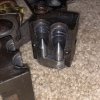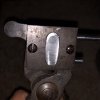I would do like Keith did and make a rectangular bar that went the width of the mould. That makes the killing of the mould faster, making the bar faster, and the cross pins enter at a right angle to the bar.Pretty impressive if you wined up with something usable for a first try with this type of project, especially at the hobby level. Nice work, Brad.
I reckon a second retrofit might go easier/faster. Anything you would do different if you tried another?
This was a good learning experience. I did learn a bunch.


